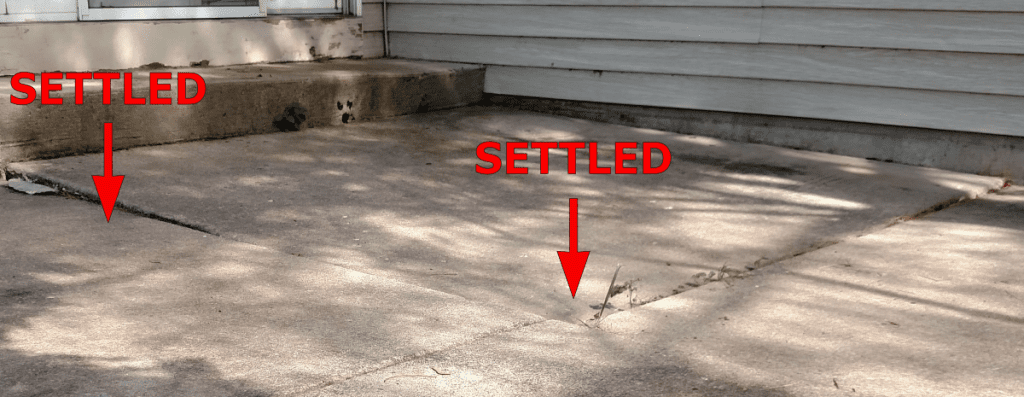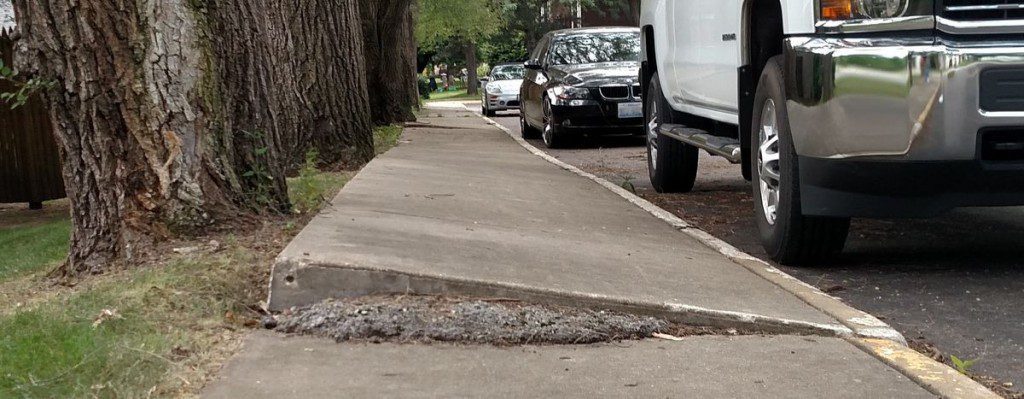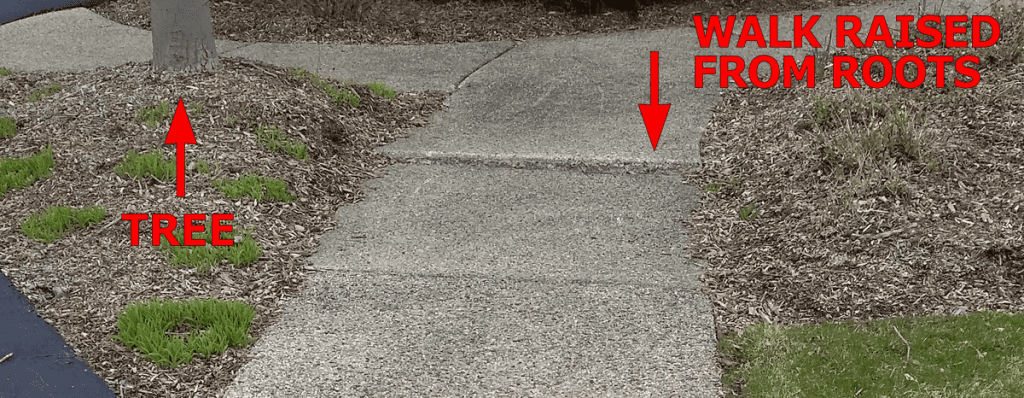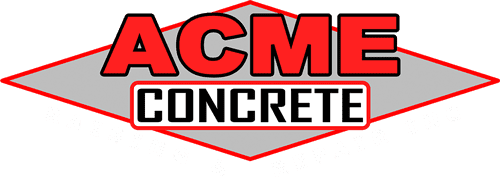How to Lower Uneven Concrete Slabs
In practical terms, concrete can not be lowered. In fact, in more cases than not, solutions to concrete problems do not involve needing to lower slabs. Most concrete trip hazards and misalignment problems develop slowly over time and are the result of concrete settling. However, you might see a problem involving an area of concrete that appears to be “raised”. Take another look. In most cases, areas appearing to be raised haven’t. They are simply alongside a slab or multiple slabs that have actually settled.

How Does the Weather Affect my Sidewalk?
In some instances, a concrete slab gets pushed up. Environmental extremes such as freezing, and drought can wreak havoc on concrete; causing individual slabs to move and become out of alignment with one another.
How Can I Lower a Concrete Slab & Fix Sidewalks Lifted by Tree Roots?
Tree root growth is probably one of the greatest factors when it comes to forcing slabs upwards. Sometimes when concrete is severely raised due to tree roots, the only practical solution is concrete removal so that the roots can be cut away.

There are also situations where concrete slabs have been raised by smaller, slow growing trees that can benefit from raising surrounding slabs in order to correct trip hazards. As a general rule of thumb, we do not suggest raising slabs higher than their original construction. However, it is sometimes simpler and more economical to raise a sidewalk slab that may not have settled in order to eliminate a trip hazard caused by another slab raised slightly by a tree root. Contact Acme Concrete to learn more about how we raise settled slabs and sidewalks with our highly effective, industrial level strong Smart Lift System.
Contact Acme Concrete Raising and Repair

In the example above, the sidewalk can be lifted to eliminate the trip hazard caused by the sidewalk that has been raised by a tree root. Just remember, the tree root can continue to grow and cause another trip hazard in the future. At some point, the only solution may be to remove the root.
Why is polyjacking a better solution than replacing the concrete slab?
Polyjacking offers several advantages over replacing a concrete slab. Firstly, it’s easy to think replacement solves the settlement problem. It might not. The new slab could sink into the same voids that caused the previous one to sink. This is because the underlying issue lies with the soil, not the slab itself. In contrast, Polyjacking can address the soil problem directly. Additionally, Polyjacking is a faster solution compared to replacing the slab. Once the polyurethane foam cures beneath the slab, it can be immediately used for driving or walking, whereas with slab replacement, one must wait at least 48 hours for the fresh concrete to cure. Also, replacing a slab involves breaking it up and hauling away the old concrete, which can create a messy and disruptive environment. Polyjacking simply requires truck mounted injection pumps and a hose, minimizing both disturbance and mess. Considering the weight aspect, a new slab will still exert pressure on weak soils, resulting in future sinking. The polyurethane foam used in Polyjacking weighs significantly less than a new slab, ranging between 2.5 to 4 pounds per cubic foot. This reduces the strain on the underlying soil and reduces the likelihood of future sinking.
Heavy concrete mixing trucks required for slab replacement can also potentially cause damage to yards or landscaping and create a significant mess. Furthermore, Polyjacking proves to be a more cost-effective solution. While replacing a concrete slab may seem like a sure fix, it often comes without much of a warranty against future problems. In contrast, Polyjacking can offer a permanent solution with a solid warranty, saving you money in the long run.
In summary, Polyjacking emerges as a superior solution to replacing a concrete slab due to its ability to address the underlying soil problem, its faster implementation, cleanliness, reduced weight, safety, cost-effectiveness, and long-lasting results.
What is polyjacking, and how does it work?
Polyjacking is the superior method used to level sunken concrete slabs by injecting expanding polyurethane foam beneath them. This technique is particularly effective for filling gaps created by tree root removal, although it may not be suitable if the concrete is severely cracked due to tree root damage. Polyjacking can be performed on various types of concrete surfaces, including sidewalks, patios, driveways, pool decks, and interior slabs like garage floors. To begin the Polyjacking process, small holes, about the size of a dime, are drilled into the sunken concrete slab. Through these holes, expanding polyurethane foam is injected into the void underneath the slab. As the foam gradually fills the void, it raises the concrete slab back to its original level. Once the slab is properly leveled, the foam injection is stopped, and the holes created during the process are patched. After approximately fifteen minutes, allowing the foam to cure, the concrete slab becomes sturdy enough to be walked on or have vehicles driven over it. Ultimately, Polyjacking provides a practical and efficient solution for correcting uneven concrete surfaces caused by various factors, such as removed tree roots.
If You Have Settled Concrete – We Can Help!
Based in Crystal Lake, IL Acme Concrete specializes in providing modern concrete raising services for residential properties and polyjacking commercial sidewalks across Chicago’s suburbs. Contact Acme Concrete Raising and Repair today if you have a problem with settled concrete or if you would like to schedule a free estimate for concrete repair services, including:

